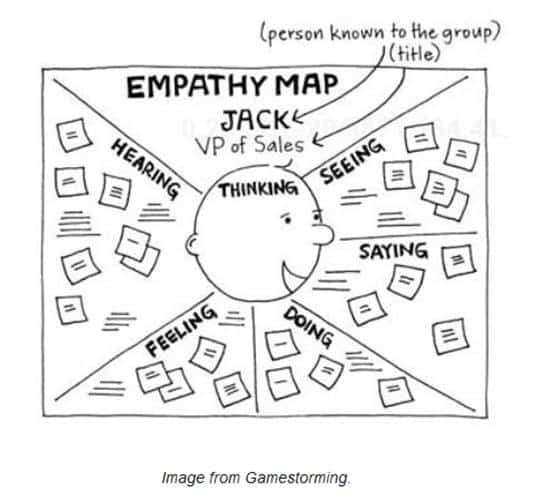Using Empathy Mapping To Create Conference Target Market Personas
We could all use a little more empathy…and a little less yelling!
And your organization could definitely cultivate more empathetic team members who help plan and design your conference and education offerings.
Why We Need More Empathy For Our Stakeholders
Empathy is walking in another person’s shoes and understanding life through their eyes. It is trying to experience and feel what they are feeling.
When we experience empathy, we are known to increase our helping behaviors.
It’s important that all of us better understand our target market customers. And to see their work through their lens. The challenges they face. The hurdles they have to overcome. The issues that keep them up at night.
Perspective–Taking, as psychologist Mark Davis calls it, is cognitive form of empathy of being able to see things from another person’s point of view. And it is critical when designing programs or services for your target market.
Unlocking Your Conference Team’s Empathy, Unlocks Innovation
Adam Waytz, an assistant professor of management and organizations at the Kellogg School of Management, says that organizations that cultivate empathetic employees see returns when working with customers. He says it often leads to innovation.
When companies allow a deep emotional understanding of people’s needs to inspire them — and transform their work, their teams, and even their organization at large — they unlock the creative capacity for innovation. ~ IDEO’s Empathy On Edge white paper.
IDEO’s white paper points to the fact that organizations have to find ways to help their employees sustain empathy for their customers. They need some type of artifact that serves as a reminder of the emotional understanding they need to have for their target markets.
Creating Conference Persona Empathy Maps
Identifying and describing the top three to five target markets for you conference is critical to your conference success. Gone are the days when you can be all things to all people with your conference programming.
Once you’ve identified those top target markets for conference growth, this 15-minute activity per persona will help you build more empathy for those stakeholders.
Empathy Maps were popular among many business trainers for years. Scott Matthews of XPLANE (PDF of Empathy Map Poster) and Dave Grey of Gamestorming were two of the first to publish the steps for Empathy Mapping. The following steps are adapted from their work.
Creating an empathy map is not a rigorous, research-based process. However it can help a conference planning team quickly focus on the most important element: people. The goal is to create more empathy for each of your conference target customers.
- Draw a large head in the center of the paper. Label it Thinking. This is the head of the first persona of your target market.
- Give the persona a name and put it at the top of the paper along with that person’s title.
- Divide the remaining areas around the head into five areas and label each area one of the following: Hearing, Seeing, Feeling, Doing, and Saying.
- Distribute sticky notes to everyone and start with one of the areas. Ask each team member to write one idea per sticky note for the specific area, describing from the persona’s point of view, what they are experiencing.
- Move through each of the categories.
- When finished, ask the group to individually answer the following questions
- What does this person want?
- What forces are motivating this person?
- What can we do for this person?
Throughout the conference planning stages, team members should constantly refer back to their empathy maps asking, “What will so-and-so think about this?”
How does empathy mapping actually help with conference planning and programming? What hinders empathy mapping or empathy design into practice?




THANK you for this. People seem to have limited or no empathy or are uncomfortable exercising their empathy gene. Is it because it’s a ‘feeling’ thing and people believe showing emotions (and empathy) makes them appear “soft” .. whatever that means?!
Jeff, in your research for this blog, did you discover how people without empathy manage and if they can do this exercise at all? In talking w/ some medical professionals about empathy, there seem to be those who do not possess it.
I think too that observation of people at conferences helps empower empathy in others. It’s taking one’s nose out of an electronic device and regarding others as human beings.
As a side note, because I work with ADA issues, and did a session at Convening Leaders in January (and will do a similar but different session at the CMP Conclave), our experience was that putting people in others’ situations created a greater sense of empathy. What more can we do besides mapping?
‘@Joan
Thanks for reading and commenting.
The empathy mapping exercise helps people practice empathy. The more we practice thinking about others through their lens, the better we get at it. Once you start it, it involved mirror neurons which mirror the behaviors of others.
Yes, there are always going to be some people who are not good at it as you mentioned.
This exercise should be used when an organization has identified their target market for their conference. Then they should design programs and services around their needs, feelings, etc. It helps them walk in those customers shoes, just as you did with the ADA issues.
Jeff – Thanks. Could we have a session please at PCMA’s ed conf next year on this?
[…] then you can go about determining what issues matter most to them. This is a great place to use the Empathy Mapping to identify their wants, needs and fears. What scares them? What inspires them? What challenges […]
Jeff – I like this. It’s very similar to a process I learned from a good friend, Gordon Rudow, at Bonfire Communications. We’ve done mapping a few times using an audience-centric approach where we identify audiences and them map macro and micro concerns, which then lead us to establishing objectives and communication strategies against those concerns. We then map out a similar process of thinking, feeling, knowing, doing and a “northstar” message – where we think about fundamentally where we want to potentially move them from a current state. This would all be done before we ever talk about any event logistics in an ideal world. This kind of process, whether the one I have used or the one you describe here can be powerful for an events team and other stakeholders to go through to better understand how to deliver value to individuals and associated personas at an event. Great stuff!
‘@Paul
Love your thoughts about creating a “northstar” message and that you go through an audience-centric mapping approach before you ever talk about event logistics! That’s a powerful message for meetings and event professionals for sure.
Thanks for reading and sharing as always. Greatly appreciate your insights.
[…] Using Empathy Mapping To Create Conference Target Market Personas […]
[…] for a conference to have a call for speaker proposals to select speakers and topics. We’ve got to understand the most pressing issues that our target customers face. We’ve got to walk in their shoes to identify their current needs and help them find […]